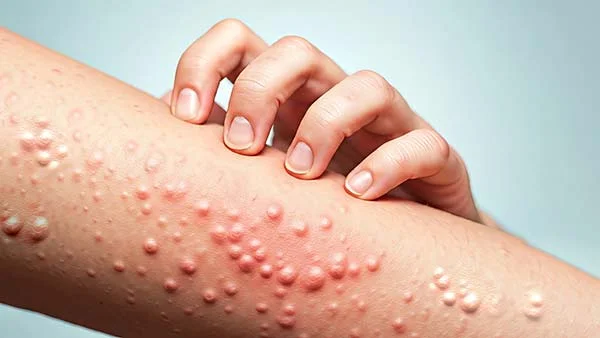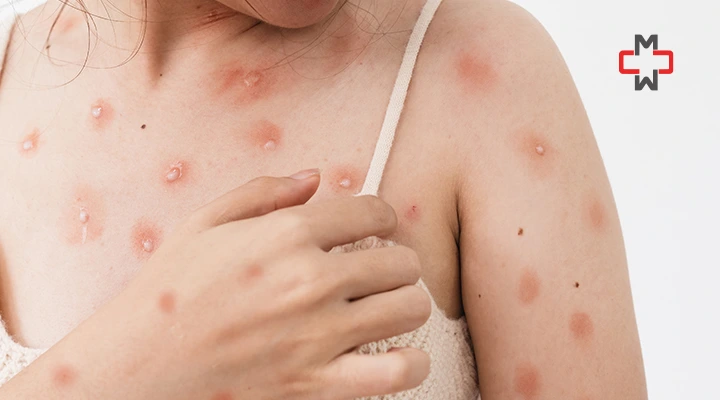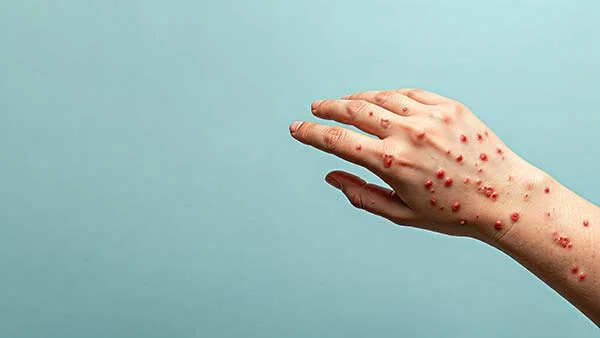What is Monkeypox?
Monkeypox, or “mpox,” is a zoonotic disease caused by the monkeypox virus, which is in the same family as the smallpox virus. Initially identified in non-human primates, the virus is now known to infect humans, with outbreaks primarily in Central and West Africa, particularly in the Republic of the Congo, the Democratic Republic of the Congo, and other African countries. With recent global outbreaks, the World Health Organization (WHO) has declared mpox a public health emergency of international concern.
What Are the Causes of Monkeypox?
Animal-to-Human Transmission:
- Infected animal contact: Direct contact with infected animals or animal products.
Human-to-Human Transmission:
- Skin-to-skin contact: Direct contact with infected skin lesions or bodily fluids.
- Sexual contact: Transmission through intimate contact.
- Contaminated materials: Bedding, clothing, or surfaces.
Risk Factors:
- Weakened immune system: Increased risk for pregnant individuals, the elderly, and those with chronic diseases.
- Poor hygiene: Lack of sanitation increases transmission.
- Climate change & urbanization: Animal migration and human-animal interactions raise risk.
- Unsustainable hunting/trade: Increases human exposure to infected animals.
High-Risk Groups:
- MSM and multiple sex partners: Higher risk in areas with ongoing outbreaks.
- Healthcare & laboratory workers: Increased exposure to infected materials.
- Travelers to endemic areas: Risk in regions where monkeypox is common.
Environmental Factors:
- Poor hygiene & sanitation: Increases chances of transmission.
- Climate change & urbanization: Changes in animal migration and close human-animal contact heighten risk.
- Unsustainable hunting/trade: Exposure to infected wildlife increases the risk of transmission.
How Long Does Monkeypox Last?
The incubation period for mpox is usually between 5 to 21 days, followed by an illness duration of 2 to 4 weeks. Symptoms typically last 2 to 3 weeks, during which the infected individual remains contagious.
How Long Do You Need to Quarantine for Monkeypox?
Quarantine is recommended for the full contagious period until all skin lesions have scabbed over and healed. This generally aligns with the 2 to 4 week illness duration.
What Does Monkeypox Look Like?
Mpox often presents as a painful rash that develops into fluid-filled blisters, then scabs over. Skin-to-skin contact can spread the virus, and mucosal lesions may appear around the mouth and genitals. Mpox rash pictures show characteristic lesions that can leave scars as they heal.

What Are the Symptoms of Monkeypox?
Symptoms of mpox generally include:
- Skin Rash: This can spread to different body parts and is often painful.
- Flu-like symptoms: Fever, sore throat, muscle aches, fatigue, and headaches.
- Swollen Lymph Nodes: Lymph nodes are small, bean-shaped organs that help fight infections. They’re located throughout the body, particularly in the:
- Neck
- Armpits
- Groin
- Underarms
- Other Symptoms: Chills, fatigue, and sore throat.
Difference Between Monkeypox vs Smallpox
Key Differences:
- Transmission:
- Monkeypox (Mpox): Animal-to-human transmission
- Smallpox: Human-to-human transmission
- Severity:
- Monkeypox: 1-10% mortality rate
- Smallpox: 20-40% mortality rate
- Symptoms:
- Monkeypox: Fever, headache, rash, swollen lymph nodes
- Smallpox: High fever, headache, fatigue, rash
- Incubation Period:
- Monkeypox: 5-21 days
- Smallpox: 10-14 days
Monkeypox in Adults vs Children
Adults:
- More severe symptoms
- Higher risk of complications
- More likely to transmit the virus
Children:
- Milder symptoms
- Higher risk of severe illness due to weaker immune systems
- Require close monitoring
How is Monkeypox Transmitted?
Mpox can spread through:
- Animal-to-Human Transmission: From contact with an infected animal.
- Human-to-Human Transmission: Close contact, sexual transmission, and skin-to-skin contact with infected persons or their bodily fluids.
- Indirect Transmission: Through contaminated materials, such as clothing or surfaces.
What Are the Risk Factors for Monkeypox?
Higher-risk groups include:
- Individuals in close contact with people with mpox
- Healthcare workers without adequate personal protective equipment (PPE)
- Pregnant people, those with weakened immune systems, and individuals with multiple sex partners or who engage in intimate contact, like sex workers.
How is Monkeypox Diagnosed?
Laboratory Tests:
- PCR (Polymerase Chain Reaction) Testing
- It detects viral DNA and is commonly used for accurate diagnosis.
- Blood Tests (Antibody Detection)
- Identifies immune response to the virus by detecting antibodies.
- Serology Tests
- Used to detect antibodies in the blood, indicating past exposure to the virus.
- Viral Culture
- Cultures the virus from a lesion sample to confirm infection.
- Antigen Detection Tests
- Detects specific proteins of the virus in clinical samples.
Other Diagnostic Methods:
- Imaging Studies (X-rays, CT scans, MRI)
- Used to evaluate complications like pneumonia or encephalitis.
- Physical Examination
- Identifies characteristic rashes and lesions associated with mpox.
- Epidemiological Investigation
- Assesses patient’s exposure to suspected cases or high-risk areas.
- Molecular Diagnostics (NGS, Real-time PCR)
- Advanced molecular techniques to identify and sequence viral genetic material.
Diagnostic Criteria:
- Confirmed:
- Positive PCR or viral culture results.
- Probable:
- Clinical symptoms, epidemiological link, and positive serology.
- Suspected:
- Clinical symptoms and history of exposure.
New Diagnostic Technologies:
- Rapid Diagnostic Tests (RDTs)
- Quick, point-of-care tests to detect mpox antigens or antibodies.
- Loop-Mediated Isothermal Amplification (LAMP)
- A rapid, cost-effective technique to amplify viral DNA for detection.
- Nanopore Sequencing
- Real-time sequencing method used for virus identification and mutation tracking.
How to Treat Monkeypox?
There is no cure for mpox, though supportive treatment is available. Pain relief, antivirals, and sometimes antibiotics for secondary infections can help manage symptoms. Those with a severe disease may require intensive medical care, especially if they experience complications like respiratory distress.
What Are the Complications of Monkeypox?
Complications of Monkeypox
While Monkeypox (mpox) is generally self-limiting, severe cases can lead to serious complications, especially in high-risk individuals.
- Bacterial Infections
- Why it can happen: Open skin lesions provide entry points for bacteria, leading to secondary infections.
- Types: Staphylococcus aureus, Streptococcus pyogenes, and other bacteria.
- Symptoms: Increased redness, swelling, pain, and pus around lesions.
- Treatment: Antibiotics, wound care, and supportive therapy.
- Loss of Vision
- Why it can happen: Corneal ulcers or conjunctivitis due to mpox lesions in the eyes.
- Symptoms: Blurred vision, eye pain, redness, and sensitivity to light.
- Treatment: Antiviral medications, topical antibiotics, and supportive eye care.
- Myopericarditis
- Why it can happen: Inflammation of the heart muscle and surrounding tissue due to viral infection.
- Symptoms: Chest pain, shortness of breath, fatigue, and palpitations.
- Treatment: Antiviral medications, pain management, and cardiac monitoring.
- Encephalitis
- Why it can happen: Rarely, mpox virus can infect the brain, leading to inflammation.
- Symptoms: Headache, fever, confusion, seizures, and altered mental status.
- Treatment: Antiviral medications, supportive care, and neurological monitoring.
- Pneumonia
- Why it can happen: Respiratory complications due to viral infection or secondary bacterial infections.
- Symptoms: Cough, difficulty breathing, chest pain, and fever.
- Treatment: Antiviral medications, antibiotics (if bacterial), oxygen therapy, and respiratory support.
- Respiratory Distress
- Why it can happen: Severe pneumonia or acute respiratory failure due to mpox.
- Symptoms: Difficulty breathing, rapid breathing rate, and low oxygen saturation.
- Treatment: Oxygen therapy, mechanical ventilation, and intensive care.
- Severe Scarring
- Why it can happen: Deep or widespread skin lesions can lead to permanent scarring.
- Symptoms: Disfiguring scars, skin discoloration, and potential long-term psychological impact.
- Treatment: Supportive care, wound management, and potential surgical interventions.
These complications highlight the importance of:
- Prompt medical attention for severe symptoms.
- Effective treatment and supportive care.
- Vaccination and prevention strategies.
- Close monitoring for high-risk individuals.
What is the Mortality Rate for Monkeypox?
The mortality rate of mpox varies widely, influenced by healthcare quality, region, and individual health factors.
- Overall Mortality Rate: 1-10% (WHO)
- Central Africa: 1-2%, supported by improved healthcare
- West Africa: 3-5%, higher due to limited healthcare access
- Severe Cases: Up to 20-30% in immunocompromised individuals
Factors Influencing Mortality Rate
- Healthcare access and quality
- Regional differences (e.g., Central vs. West Africa)
- Age (children, pregnant people, and older adults are more vulnerable)
- Immune status (weakened immunity raises risks)
- Co-infections, including HIV/AIDS and tuberculosis
- Treatment timeliness and effectiveness
Comparison to Other Viruses
- Smallpox: 20-40% mortality (significantly higher than mpox)
- Measles: 1-3% (comparable to mpox in some areas)
- COVID-19: 0.5-5% (variable by demographics)
Regional Mortality Differences
- Central Africa: Lower mortality due to better healthcare systems
- West Africa: Higher due to limited resources
- Other Regions: Mortality varies based on healthcare access and population factors
Recent Outbreaks and U.S. Statistics
- 2022 Global Outbreak: 49,000+ cases, 26 deaths globally (~0.05% mortality rate)
- U.S. (2022): 18,000+ cases, 2 deaths
Treatments and Prevention
- Vaccination (JYNNEOS, ~85% effective)
- Antiviral treatments
- Supportive care (e.g., pain management, hydration)
- Isolation and contact tracing
- Improved hygiene practices
Role of Vaccination in Reducing Mortality
- The JYNNEOS vaccine prevents severe disease and curtails spread.
- Vaccination reduces overall mortality and has proven effective in reducing mpox fatalities in prior African campaigns.
Understanding these factors helps manage mpox risks and supports informed preventive measures for both healthcare providers and the public.
Is Monkeypox Curable?
Mpox is usually self-limiting and resolves in about 2 to 4 weeks without specific treatment. Treatments help alleviate symptoms and reduce transmission.
How to Prevent Monkeypox
Prevention involves:
- Vaccination: Mpox vaccines, such as the JYNNEOS vaccine, are available for those at higher risk.
- Limit Close Contact: Avoid close or intimate contact with infected individuals.
- Hygiene and Disinfection: Clean and disinfect surfaces regularly.
- PPE: Healthcare providers should use PPE, especially in disease outbreak areas.
- Avoid Contact with Infected Animals: Many cases in Central and East Africa have originated from contact with animals.
When Should I Get Vaccinated?
People who are at increased risk, such as those in close contact with infected individuals or healthcare workers, should receive the mpox vaccine. It typically takes a few weeks after vaccination to reach optimal immunity.
How Does the Monkeypox Vaccination Work?
The mpox vaccine prepares the immune system to recognize and fight the virus, helping prevent severe illness and lower transmission rates.
When to Contact a Medical Professional
Seek medical care if mpox symptoms develop, particularly if you are in a higher-risk group or experience severe symptoms.
Frequently Asked Questions
Is Monkeypox Worse Than Chickenpox?
While chickenpox is typically mild and more common in children, mpox is generally more severe and can lead to significant complications, particularly for high-risk individuals like those with weakened immune systems. Compared to chickenpox, mpox also has a more extensive rash and systemic symptoms.
Does Monkeypox Go Away on Its Own?
Yes, in most cases, mpox will resolve independently within two to four weeks. However, some individuals, especially those with compromised immune systems or other health risks, may experience more prolonged or severe symptoms. Medical care and supportive treatment may help reduce discomfort and risk.
What Are the First Signs of Monkeypox?
The first signs of mpox resemble flu-like symptoms, including fever, chills, muscle aches, fatigue, and headache. Swollen lymph nodes are also common, which helps distinguish mpox from other conditions. Shortly after, a distinctive rash appears, which progresses through various stages, including fluid-filled lesions.
Where Does the Monkeypox Rash Start?
Typically, the mpox rash begins on the face, particularly around the mouth and eyes, before spreading to other areas of the body, such as the arms, legs, and trunk. The rash can be widespread and evolve from flat lesions to pustules and scabs. Skin-to-skin contact can easily spread the infection.
How to Avoid Monkeypox?
To avoid mpox, limit close contact with infected individuals or animals, as the virus spreads through direct contact. Maintain good hygiene by washing hands frequently, use personal protective equipment if at high risk, avoid sharing items, and get vaccinated if exposed or recommended by health authorities.
What Age Group is Most Affected by Monkeypox?
While mpox can impact individuals of all ages, children, pregnant individuals, and people with weakened immune systems are at higher risk for severe cases. Historically, certain African regions experience higher transmission rates, but outbreaks in other areas highlight the need for vigilance across all age groups.
Is Monkeypox Itchy?
Yes, the mpox rash often becomes itchy and painful as it progresses. Lesions can range from mildly irritating to very uncomfortable, especially as they blister and scab over. In addition to itching, some people may experience additional discomfort or secondary skin infections if lesions are scratched.
Is Monkeypox Deadly?
Mpox is not usually fatal, with most cases being mild to moderate. However, it can lead to severe disease, especially for high-risk groups such as individuals with compromised immune systems, young children, and pregnant individuals. Prompt treatment and vaccination can help mitigate these risks.
Can You Get Monkeypox Twice?
Though rare, reinfection with mpox is possible, especially if immunity from the first infection fades or if exposed to a new strain. If exposed again, people with compromised immune systems or who experience only mild initial cases may have a higher chance of reinfection.
Is Monkeypox Seasonal or Can It Occur Year-Round?
Mpox is not seasonal and can occur year-round, especially in regions with endemic cases, like Central and West Africa. The virus can spread in any season, and factors like travel, close contact, and environmental conditions can influence outbreak patterns in non-endemic areas.
– Disclaimer –
This blog is for informational & educational purposes only and does not intend to substitute any professional medical advice or consultation. For any health-related concerns, please consult with your physician, or call 911.
-
About The Author
Dr. Syra Hanif M.D.Board Certified Primary Care Physician
Dr. Syra Hanif is a board-certified Primary Care Physician (PCP) dedicated to providing compassionate, patient-centered healthcare.
Read More








